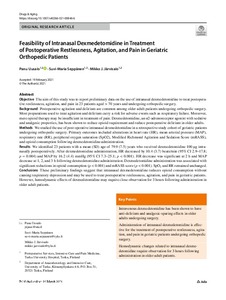Feasibility of Intranasal Dexmedetomidine in Treatment of Postoperative Restlessness, Agitation, and Pain in Geriatric Orthopedic Patients
Järvisalo Mikko J; Seppänen Suvi-Maria; Uusalo Panu
Feasibility of Intranasal Dexmedetomidine in Treatment of Postoperative Restlessness, Agitation, and Pain in Geriatric Orthopedic Patients
Järvisalo Mikko J
Seppänen Suvi-Maria
Uusalo Panu
ADIS INT LTD
Julkaisun pysyvä osoite on:
https://urn.fi/URN:NBN:fi-fe2021042823604
https://urn.fi/URN:NBN:fi-fe2021042823604
Tiivistelmä
Objective The aim of this study was to report preliminary data on the use of intranasal dexmedetomidine to treat postoperative restlessness, agitation, and pain in 23 patients aged > 70 years and undergoing orthopedic surgery. Background Postoperative agitation and delirium are common among older adult patients undergoing orthopedic surgery. Most preparations used to treat agitation and delirium carry a risk for adverse events such as respiratory failure. Moreover, mere opioid therapy may be insufficient in treatment of pain. Dexmedetomidine, an alpha 2-adrenoreceptor agonist with sedative and analgesic properties, has been shown to reduce opioid requirement and reduce postoperative delirium in older adults. Methods We studied the use of post-operative intranasal dexmedetomidine in a retrospective study cohort of geriatric patients undergoing orthopedic surgery. Primary outcomes included alterations in heart rate (HR), mean arterial pressure (MAP), respiratory rate (RR), peripheral oxygen saturation (SpO2), Modified Richmond Agitation and Sedation Score (mRASS), and opioid consumption following dexmedetomidine administration. Results We identified 23 patients with a mean (SD) age of 79.9 (7.5) years who received dexmedetomidine 100 mu g intranasally postoperatively. After dexmedetomidine administration, HR decreased by 10.4 (3.7) beats/min (95% CI 2.9-17.8; p = 0.004) and MAP by 16.2 (4.4) mmHg (95% CI 7.3-25.1; p < 0.001). HR decrease was significant at 2 h and MAP decrease at 1, 2, and 3 h following dexmedetomidine administration. Dexmedetomidine administration was associated with significant reductions in opioid consumption (p < 0.001) and mRASS score (p < 0.001). SpO(2) and RR remained unchanged. Conclusions These preliminary findings suggest that intranasal dexmedetomidine reduces opioid consumption without causing respiratory depression and may be used to treat postoperative restlessness, agitation, and pain in geriatric patients. However, hemodynamic effects of dexmedetomidine may require close observation for 3 hours following administration in older adult patients.
Kokoelmat
- Rinnakkaistallenteet [19207]
